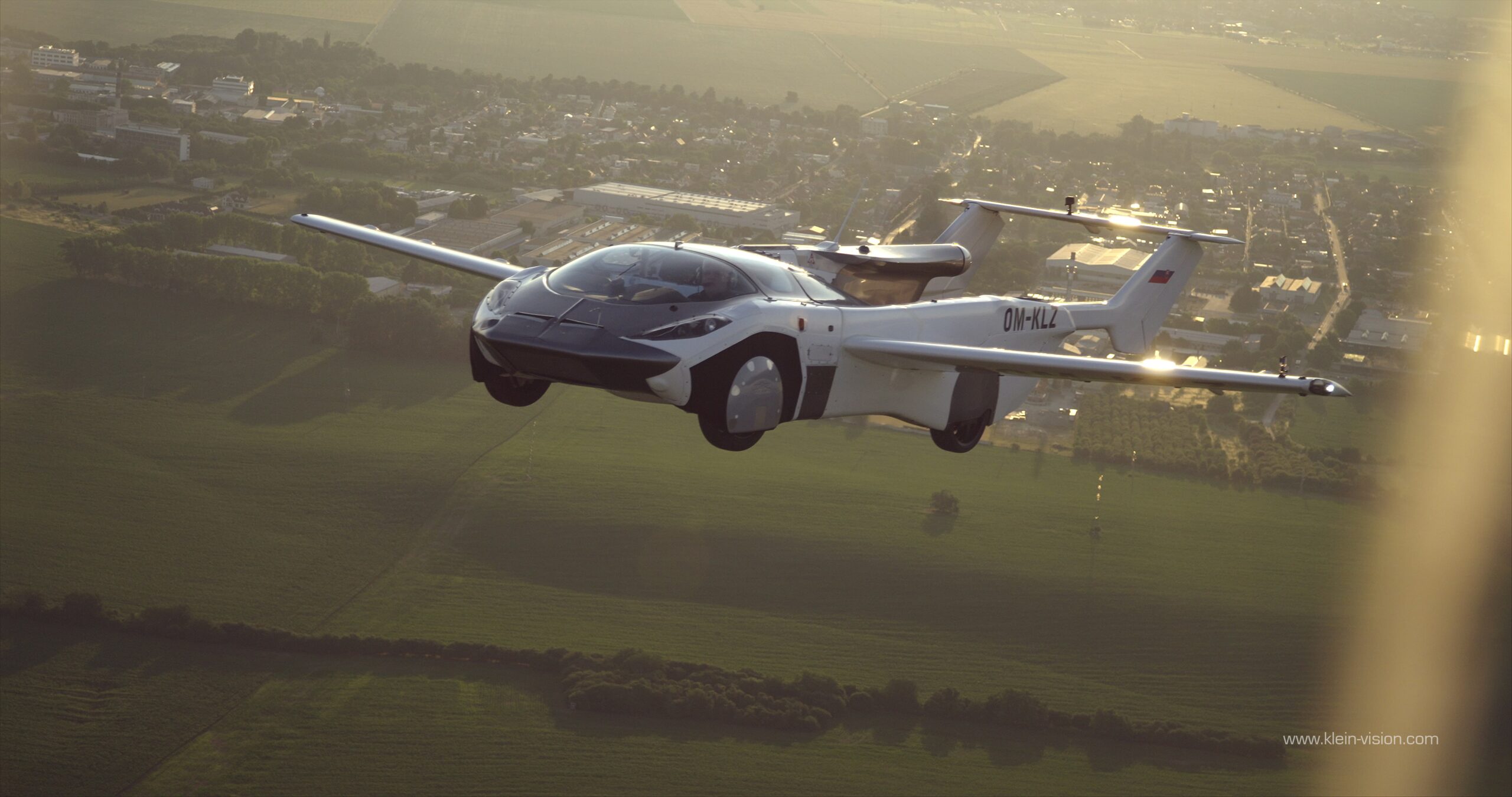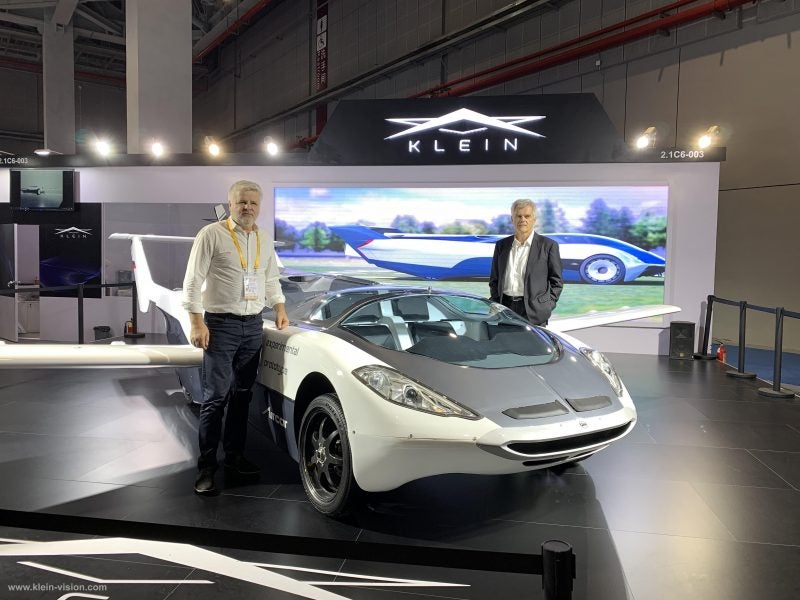
AirCar, a dual-mode flying car designed by Slovakian inventor Professor Stefan Klein, accomplished the first trip between two international airports on 28 June, taking off from Nitra – a city east of Bratislava – and landing in the Slovakian capital. Once landed, Klein and fellow co-founder Anton Zajac drove the car to the centre of Bratislava.
The model, which can transform between aircraft and car in around two minutes, has a fixed-propeller engine and can reach 170km/h.

Discover B2B Marketing That Performs
Combine business intelligence and editorial excellence to reach engaged professionals across 36 leading media platforms.
“Professor Stefan Klein is the world leader in the development of user-friendly flying cars,” said Boeing senior technical fellow Dr. Branko Sarh.
“The automated transition from road vehicle into an air vehicle and vice versa, deploying/retracting wings and tail is not only the result of pioneering enthusiasm, innovative spirit and courage; it is an outcome of excellent engineering and professional knowledge.”
Stefan Klein and co-founder Anton Zajac talk about the trip from Nitra to Bratislava, the project’s genesis and the future.

US Tariffs are shifting - will you react or anticipate?
Don’t let policy changes catch you off guard. Stay proactive with real-time data and expert analysis.
By GlobalData
Credit: Klein Vision.
Ilaria Grasso Macola (IGM): For those who don’t know, what was the project’s background and the rationale behind it?
Anton Zajac (AZ): This is a project that has a longer history than you would expect. It started when Professor Klein did his master’s thesis at the University of Bratislava, but the project’s conception is even older because Stefan’s family, his grandfather and father, were creating flying vehicles. And so, his lifetime dream was to create a vehicle that he could fly from Nitra to Bratislava, then convert into a car and drive to the main square and have coffee. And this is what exactly happened on Monday.
Stefan Klein (SK): As Anton said, I started developing the flying car in 1989 during the Velvet Revolution (a series of non-violent demonstrations against the Czechoslovakian communist Government), because we had this romantic feeling that Europe would be now open [to all]. I finished the design whilst attending the Academy of Fine Arts, but I wanted this idea to see the completion of this idea. I can say that the research started in 1989 but the completed product was tested on Monday.
IGM: What were the steps you took from designing it to production?
AZ: This is the fifth model that Professor Klein designed and created that was brought to life. This is the most advanced one and it started with an inspiration that was triggered by the Czech Tatra car model, which was very unstable on the road because it had an aerodynamic shape. If you want to create a flying car that you can actually call a flying car, you need to come up with some innovative ideas. For example, If you have long wings in a flying car, it’s extremely difficult to fold the wings in such a way that you would end up having a car, whereas you might have a van.
The fuselage of this flying car is a wing itself, given that about 25% of the lift of this flying car comes from the body. As a result, the wings are not as long as they would otherwise have to be. And so when this car transforms from aircraft mode into car mode, it’s a fully-fledged sports car.
IGM: What were the challenges you encountered during the project’s development?
SK: We didn’t want to develop a defective car or plane so, for me, creating a solution that offered good function for the car as well as the plane was the biggest challenge. As a test pilot, I’m very satisfied with the characteristics of the plane because they are perfect. But regarding the car part, in quality of designer and engineering, I would like to create a very attractive shape for the car, similar to sports cars such as Lamborghini and Ferrari.
IGM: Let’s talk about last Monday’s test flight. Can you talk us through what happened?
SK: I decided that I wanted to fly to Bratislava and send the flight plan, taking off from Nitra Airport at around 5.30am. After 25 minutes, I landed at Bratislava International Airport, between Boeings and big aircraft. We then transformed the car and continued driving to the town centre, where we had coffee in my university’s cafe.
AZ: The AirCar took off from a grass surface and landed on the concrete surface of a major airport. During the flight, Stefan didn’t have to interfere because AirCar’s manoeuvrability and stability is extremely high. AirCar’s key point is the transformation between the two modes, either from a car into an aircraft or vice versa. The technology – which is patent-protected – leads to the wings spreading and the tail elongating. The control surfaces of the AirCar are far from the centre of gravity, which adds to its stability during take-off.
IGM: How is the car powered?
AZ: Aircar is ready for any sort of power. We can use electric power or any combustion engine, provided that the batteries support high energy content or the batteries are not too heavy. The engine that we currently use in this model is taken from a motorcycle, so it’s certified. The new engine that we are going to implement is certified and will comply with all the standards.
The current model has 160hp engine while the new model will have 300hp, with an increased speed up to 300km, which makes it a relatively fast aircraft.
IGM: In terms of safety, how will flying cars interact with regulations and civil aviation?
AZ: When AirCar is in aircraft mode, it’s a proper aircraft and it must comply with all the standards imposed by civil aviation authorities and air traffic control agencies. On the road, we currently have an M class certification, which allows the experimental design and production of a limited number of vehicles per year.
IGM: Many people believe that the 2020s will be the decade of electric vertical takeoff and landing (eVTOL) vehicles and flying cars. How far is the industry from reaching that goal?
AZ: There’s a growing trend in the merge of the aircraft and car industry. There’s no question about the future, there are going to be both vertical takeoff and landing (VTOL) vehicles and flying cars. Currently, the problem with VTOL vehicles is that their energy density is very low, their batteries very heavy and they have a very long charging cycle.
VTOL vehicles can take you through short distances. But if take into account how many people would use them, it creates huge traffic and there no infrastructure available that will allow the mass use of VTOL vehicles.
AirCar is far more efficient because it uses the lift generated by the wings and so the amount of energy that we spend for travelling one mile is much less than the energy used for VTOL vehicles.
SK: It’s necessary to say that flying cars are not a general solution for transportation problems, it’s an alternative. In the future, we will have two types of vehicles: VTOL vehicles are a good solution in megacities and for urban transportation because they will use roofs as taking-off and landing pads.
Our target is different, we would like to open transportation to suburban areas, [moving] from point A to point B, but we would like to keep this flying car character.
IGM: What’s next?
AZ: We have completed 45 test flight hours on prototype one, and we need to finish five additional hours because these test flights are all done under the supervision of [the Slovakian] Civil Aviation Authority. In parallel, we are working on prototype two and we’re already testing the engine, with all the drawings and all the design elements are in place. It will take us about eight to ten months to finalise prototype two. We will do the test flights and then we’ll go and either start production of the experimental kits, and at the same time, we will be trying to get the CS23 certification, so that we could certify the flying car, leading to serial production.





